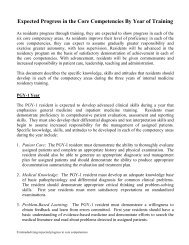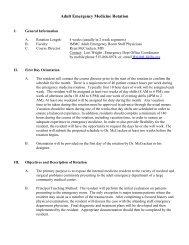Functional Adrenal Tumors
Functional Adrenal Tumors
Functional Adrenal Tumors
You also want an ePaper? Increase the reach of your titles
YUMPU automatically turns print PDFs into web optimized ePapers that Google loves.
<strong>Functional</strong> <strong>Adrenal</strong> Disorders<br />
David F. Schneider, MD, MS
NOTHING TO DISCLOSE
OBJECTIVES<br />
• Recognize the presentation of aldosteronoma,<br />
Cushing’s syndrome, and pheochromocytoma<br />
• Make the biochemical diagnosis for functional<br />
adrenal masses<br />
• Know how to diagnose and treat adrenal<br />
insufficiency<br />
• Understand when adrenal venous sampling is<br />
indicated<br />
• Describe the proper order for diagnosis and<br />
localization of functional adrenal masses
Case #1<br />
A 47-year-old woman has a recent onset on<br />
headaches, palpitations, sweating, and heat<br />
intolerance. On physical exam, her blood<br />
pressure is 190/100 and her heart rate is 110<br />
bpm. Biochemical evaluation revealed an<br />
elevated plasma metanephrine level and<br />
elevated 24-hour urinary metanephrines. A CT<br />
scan of the abdomen is obtained.
Pheochromocytoma<br />
• Catecholamine-producing tumor of chromaffin<br />
cells<br />
• 0.1% of all hypertensive patients<br />
• “Rule of 10s”<br />
• 10% bilateral<br />
• 10% extra-adrenal (20% = paraganglioma)<br />
• 10% malignant<br />
• 10% multiple<br />
• 10% familial (24-40%)<br />
• MEN2, VHL, neurofibromatosis type 1 SDHB, SDHC,<br />
SDHD
Pheochromocytoma:<br />
Signs and Symptoms<br />
Abdominal<br />
pain<br />
Nausea/Vomit<br />
ing<br />
Diaphoresis<br />
Headache<br />
Palpitation<br />
HTN<br />
0% 20% 40% 60% 80%<br />
50 patients, 1960-1995, UCSF
Pheochromocytoma:<br />
Biochemical Tests<br />
• Plasma and urinary catecholamines and<br />
their metabolites<br />
• Screening - 24 hr. urinary metanephrines<br />
(plasma metanephrines)<br />
• Must be off α & β-blockers, TCAs,<br />
levodopa<br />
• Inaccurate: renal insufficiency, OSA,<br />
stress (including hospitalization), trauma,<br />
surgery
Question: Case #1<br />
Left lap adrenal is planned. Pre-operative<br />
management of this patient could include all of<br />
the following EXECPT:<br />
(A) Beta-blockade for 2 weeks followed by alphablockade<br />
(B) Volume expansion<br />
(C) Blood pressure monitoring<br />
(D) Anesthesia consultation
Case 2<br />
A 51 -year-old woman reports significant<br />
weight gain over the last 6 months. In this time<br />
period, she has also had 2 episodes of urinary<br />
tract infections and has noticed that she bruises<br />
quite easily. On physical exam, her blood<br />
pressure is 150/95. She is 5’8” in height, and<br />
weighs 250 lbs. She has a characteristic bulge<br />
of fat on her back and striae on her abdomen.<br />
The diagnosis of Cushing’s syndrome is made.
Cushing’s<br />
• Central obesity<br />
• Moon facies<br />
• Supraclavicular<br />
fat pad<br />
• Purple Striae
<strong>Adrenal</strong> Cushing’s<br />
• Adenomas or carcinomas<br />
• 1-mg dexamethasone<br />
suppress cortisol < 5 µg/dL<br />
• 24 hr Ur cortisol (less<br />
sensitive)<br />
• Low plasma ACTH (ACTHindependent)<br />
• Postop Addisonian, require<br />
steroid replacement
<strong>Adrenal</strong> Insufficiency<br />
• Primary or Secondary (postoperative/steroids)<br />
• Exogenous: greatest risk ≥ 20 mg X ≥ 5 d.<br />
• If Rx > 1 month up to 6 – 12 m. of suppression<br />
• S/Sx: hyperkalemia, hypoglycemia,<br />
unexplained hypotension<br />
• Dx: ACTH stimulation test:<br />
• Give 250 mcg ACTH (IV)<br />
• Measure plasma cortisol at 0, 30, and 60 min.<br />
• + test: change from baseline < 9 μg/dL<br />
OR<br />
< 18 μg/dL at 30 or 60 min
Postoperative <strong>Adrenal</strong><br />
Insufficiency<br />
• Hydrocortisone 100 mg when vein is clipped<br />
then TID for first 24 hours postoperatively<br />
• 3 day taper on oral prednisone to maintenance<br />
dose of 5 mg daily<br />
• Wean off steroids over the next 3 – 6 months<br />
• Bilateral: will need lifelong glucocorticoid and<br />
mineralocorticoid replacement
Case 3<br />
A 62 -year-old man has a history of difficult to<br />
control HTN since 2005. He is currently on 4<br />
medications for HTN. He has also had<br />
intermittent hypokalemia (2.8 – 3.6) over that<br />
same period. PMHx also notable for “prediabetes.”<br />
A left adrenal mass was incidentally<br />
discovered in 2005 (2 cm). It grew to 3.7 cm in<br />
2011, and on his most recent CT scan it was 5<br />
cm. Exam: BMI is 32, no striae, moon facies,<br />
buffalo hump, etc.
Biochemical Evaluation<br />
• Plasma metanephrines: 46 pg/mL<br />
• Plasma normatanephrines: 97 pg/mL<br />
• Total metanephrines: 143 pg/mL<br />
• Aldosterone: 4.0 ng/dL<br />
• Renin: 0.8 ng/mL/hr<br />
Aldo:Renin N/A<br />
• Midnight salivary cortisol: 0.477 and 0.181 μg/dL<br />
(normal < 0.112)<br />
• Dexamethasone Suppression Test:<br />
• Random cortisol = 15.1 μg/dL ACTH = 7 pg/mL<br />
• AM cortisol = 4.0 μg/dL ACTH = 1.5 pg/mL
Dexamethasone Suppression Test<br />
• Measure baseline cortisol and ACTH<br />
• 1 mg Dexamethasone @ 11 pm<br />
• Cortisol and ACTH @ 8 am the next morning<br />
• Interpreting Results:<br />
• < 5 μg/dL “normal”<br />
• < 1.5 μg/dL truly normal (No Cushing’s)<br />
• 1.5 – 5 μg/dL borderline or Subclinical Cushing’s<br />
• > 5 μg/dL abnormal high dose testing (pituitary<br />
vs. adrenal vs. ectopic source)
Subclinical Hypercortisolism (SH)<br />
• Estimated to be present in 5 – 30% of patients<br />
with adrenal incidentaloma<br />
• Incidentaloma present in 4 – 7% of adults<br />
• Therefore, prevalence of SH in adult<br />
population is estimated at 0.2 – 2%<br />
• Data lacking on outcomes
Subclinical Hypercortisolism (SH)<br />
• Only one prospective randomized trial of<br />
surgical vs. follow-up management (Toniato<br />
2009)<br />
• 2/3 patients showed improvement in BP,<br />
possible improvement in FBS and no<br />
improvement in bone density<br />
• Follow-up: 24 – 204 months
Laparoscopic <strong>Adrenal</strong>ectomy<br />
• Control vein early<br />
• Coordination with<br />
Anesthesia –<br />
intraoperative<br />
medications<br />
• 3 (L) or 4 (R) small<br />
incisions<br />
• 23 hr hospital stay
Case 4<br />
During a routine GYN visit, a 33-year-old<br />
woman with a history of headaches was noted<br />
to have a blood pressure of 160/100. Her<br />
laboratory work revealed a K+ of 2.5 mmol/L.<br />
On further biochemical testing, the patient also<br />
had an elevated plasma aldosterone level and a<br />
suppressed renin level with an aldosterone to<br />
renin ratio of 50. The diagnosis of<br />
hyperaldosteronism is made.
Hyperaldosteronism: Diagnosis<br />
• Low K+ ( 20:1 with PA > 15 ng/dL<br />
• Confirmatory test: saline suppression or oral<br />
sodium loading (failure to suppress Ur Aldo)<br />
• Adenoma vs. hyperplasia<br />
• Postural studies: PA decreases upon standing 4 hrs<br />
• 18-hydrocorticosterone elevated in adenomas<br />
• NP-59 scan vs. CT scan<br />
• adrenal vein sampling = gold standard
Hyperaldosteronism: Diagnosis
• Etiology<br />
Hyperaldosteronism<br />
• Adenoma 50% (Conn’s Syndrome)<br />
• Bilateral hyperplasia<br />
• 8 - 12% of all hypertensive patients<br />
• Clinical presentation<br />
• Hypokalemia, HTN, muscle weakness<br />
• Treatment<br />
• Adenoma - lap adrenal<br />
• Hyperplasia - medical (spironolactone)<br />
non-functioning<br />
cortical adenomas<br />
increase with age<br />
need to<br />
distinguish for<br />
proper treatment
Selective <strong>Adrenal</strong> Vein Sampling<br />
> 3-4:1<br />
> 4:1
Diagnostic Algorithm:<br />
Hyperaldosteronism<br />
< 45 y/o
Aldosteronoma: Outcomes<br />
• Hypokalemia resolves 100% of the<br />
time (within 24-48 hours)<br />
• HTN: 15 – 60% normotensive<br />
without medications (3-6 months)<br />
• Predictors of cure (no need for<br />
Rx)younger patients, shorter clinical<br />
course, greater # pre-op Rx, lack of<br />
family history (HTN), good response to<br />
spironolactone<br />
• Median reduction in medications = 2<br />
• Continues to improve over 4 years<br />
Murashima et al. 2009;11:316.
QUESTIONS






